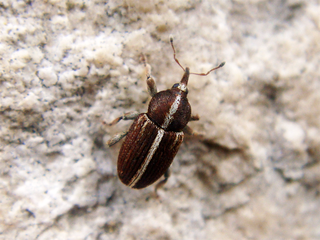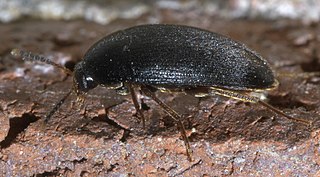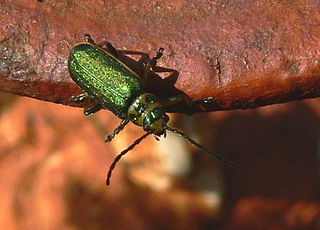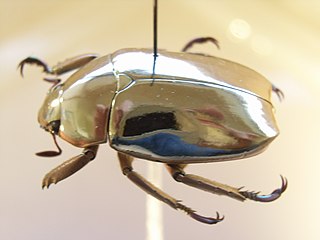
Ground beetles are a large, cosmopolitan family of beetles, the Carabidae, with more than 40,000 species worldwide, around 2,000 of which are found in North America and 2,700 in Europe. As of 2015, it is one of the 10 most species-rich animal families. They belong to the Adephaga. Members of the family are primarily carnivorous, but some members are phytophagous or omnivorous.

The soldier beetles (Cantharidae) are relatively soft-bodied, straight-sided beetles. They are cosmopolitan in distribution. One of the first described species has a color pattern reminiscent of the red coats of early British soldiers, hence the common name. They are also known commonly as leatherwings because of their soft elytra.

The rove beetles are a family (Staphylinidae) of beetles, primarily distinguished by their short elytra that typically leave more than half of their abdominal segments exposed. With roughly 63,000 species in thousands of genera, the group is currently recognized as the largest extant family of organisms. It is an ancient group, with fossilized rove beetles known from the Triassic, 200 million years ago, and possibly even earlier if the genus Leehermania proves to be a member of this family. They are an ecologically and morphologically diverse group of beetles, and commonly encountered in terrestrial ecosystems.

Blister beetles are beetles of the family Meloidae, so called for their defensive secretion of a blistering agent, cantharidin. About 7,500 species are known worldwide. Many are conspicuous and some are aposematically colored, announcing their toxicity to would-be predators.

The beetle subfamily Curculioninae is part of the weevil family Curculionidae. It contains over 23,500 described species in 2,200 genera, and is therefore the largest weevil subfamily. Given that the beetle order (Coleoptera) contains about one-quarter of all known organisms, the Curculioninae represent one of the – if not the – most successful radiations of terrestrial Metazoa.

The flea beetle is a small, jumping beetle of the leaf beetle family (Chrysomelidae), that makes up the tribe Alticini which is part of the subfamily Galerucinae. Historically the flea beetles were classified as their own subfamily.

Colydiinae is a subfamily of beetles, commonly known as cylindrical bark beetles. They have been treated historically as a family Colydiidae, but have been moved into the Zopheridae, where they constitute the bulk of the diversity of the newly expanded family, with about 140 genera worldwide. They are diverse for example in the Australian region, from where about 35 genera are known; in Europe, though, only 20 genera are found and many of these only with few species.

Tetratomidae is a small family of beetles sometimes called polypore fungus beetles. The family consists of several genera, most of which used to be in the family Melandryidae. Tetratomidae can be found worldwide.

The Cryptocephalinae are a subfamily of the leaf beetles (Chrysomelidae), and belong to the group of case-bearing leaf beetles called the Camptosomata.

The Eumolpinae are a subfamily of the leaf beetles, or Chrysomelidae. It is one of the largest subfamilies of leaf beetles, including more than 500 genera and 7000 species. They are oval, and convex in form, and measure up to 10 mm in size. Typical coloration for this subfamily of beetles ranges from bright yellow to dark red. Many species are iridescent or brilliantly metallic blue or green in appearance.

The Galerucinae are a large subfamily of the leaf beetles (Chrysomelidae), containing about 15,000 species in more than 1000 genera, of which about 500 genera and about 8000 species make up the flea beetle tribe Alticini.

Melolonthinae is a subfamily of the scarab beetles. It is a very diverse group; distributed over most of the world, it contains over 11,000 species in over 750 genera. Some authors include the scarab subfamilies Euchirinae and Pachypodinae as tribes in the Melolonthinae.

Silvanidae, "silvan flat bark beetles", is a family of beetles in the superfamily Cucujoidea, consisting of 68 described genera and about 500 described species. The family is represented on all continents except Antarctica, and is most diverse at both the generic and species levels in the Old World tropics.

Dorcasominae is a subfamily of the longhorn beetle family (Cerambycidae).

Carabinae is a subfamily of ground beetles in the family Carabidae. There are about 10 genera and more than 1,400 described species in Carabinae.

Rutelinae or shining leaf chafers is a subfamily of the scarab beetles. It is a very diverse group; distributed over most of the world, it contains some 200 genera with over 4,000 described species in 7 tribes. Several taxa have yet to be described.A few recent classifications include the tribe Hopliini, but this is not generally accepted.

Pterostichinae is a subfamily of ground beetles. It belongs to the advanced harpaline assemblage, and if these are circumscribed sensu lato as a single subfamily, Pterostichinae are downranked to a tribe Pterostichini. However, as the former Pterostichitae supertribe of the Harpalinae as loosely circumscribed does seem to constitute a lineage rather distinct from Harpalus, its core group is here considered to be the present subfamily and the Harpalinae are defined more narrowly.

Trechinae is a subfamily of ground beetles in the family Carabidae. There are 6 tribes, more than 430 genera, and over 6,700 described species in Trechinae.

Monotomidae is a family of beetles in the superfamily Cucujoidea. The family is found worldwide, with approximately 240 species in 33 genera. The ecological habits of the family are diverse, with different members of the group being found under tree bark, in decaying vegetation, on flowers and in ant nests. Their ecology is obscure, while at least some species are mycophagous, feeding on the fruiting bodies of ascomycete fungi, Rhyzophagus are predators on bark beetles and possibly Phoridae larvae, with the larvae of some species also being mycophagous.

Platynini is a large tribe of ground beetles in the family Carabidae. There are at least 190 genera and 3000 described species in Platynini.



















